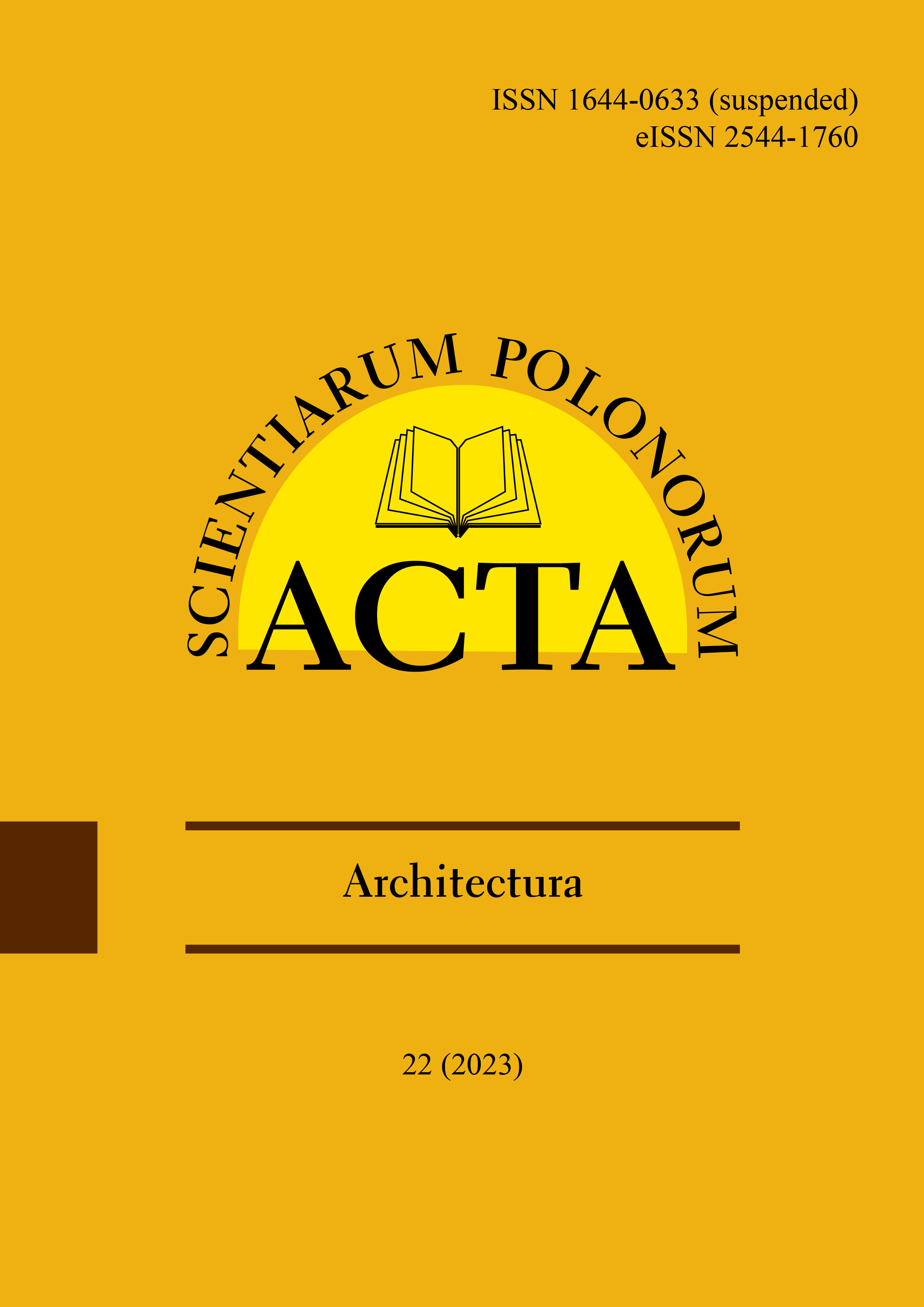Main Article Content
The economic growth of lowland areas is closely related to water management, with the development of valley areas limited by local hydrological conditions. The water retention shaped by hydro-technical structures enables the subsequent use of water for flood protection, agricultural, industrial, fire-fighting, energy, or recreational purposes, conditioning the potential development opportunities of the region. Over the years, there have been different approaches to the exploitation of water resources – from total subordination of nature by man to the development of sustainable solutions. However, to utilise the potential of rivers, channels and valleys were subjected to regulation, which in some cases provided immediate economic benefits, but in the long-term, deprived the river of its natural qualities, inhibiting its ability to self-purification morphodynamic processes. The water runoff acceleration as a result of channel straightening and concreting, combined with the narrowing of river valleys, led to a progressive increase in flood risk. As observed, over the years, such rivers increased the flood problem, oppositely to intentions. In response to deteriorating hydromorphological conditions, a variety of mitigation measures have been undertaken, which can be broadly termed as river restoration. The article presents the most common causes leading to the loss of naturalness, one of the most significant environmental effects. As demonstrated, most often, the loss of naturalness of water occurs through the influence of several factors, although in individual cases, it is possible to recognise one of them as the main threat source
Article Details
Alonso, E. E. & Cardoso, R. (2010). Behavior of materials for earth and rockfill dams: Perspective from unsaturated soil mechanics. Frontiers of Architecture and Civil Engineering in China, 4 (1), 1–39. https://doi.org/10.1007/s11709-010-0013-6 (Crossref)
Bach, M., Röpke, B. & Frede, H. G. (2005). Pesticides in rivers – Assessment of source apportionment in the context of WFD. European Water Management Online, 2, 1–14.
Bai, J., Cui, B., Cao, H., Li, A. & Zhang, B. (2013). Wetland degradation and ecological restoration. The Scientific World Journal, 523632. https://doi.org/10.1155/2013/523632 (Crossref)
Buckley, M. C. & Crone, E. E. (2008). Negative off-site impacts of ecological restoration: understanding and addressing the conflict. Conservation Biology, 22 (5), 1118–1124. (Crossref)
Directive 2000/60/EC of the European Parliament and of the Council of 23 October 2000 establishing a framework for Community action in the field of water policy. OJ L 327, 22.12.2000, pp. 1–73.
Froehlich, W. (1980). Hydrologiczne aspekty pogłębiania koryt rzek beskidzkich. Zeszyty Problemowe Postępów Nauk Rolniczych, 235 (17), 257–268.
Galay, V. J. (1983). Causes of river bed degradation. Water Resources Research, 19 (5), 1057–1090. https://doi.org/10.1029/WR019i005p01057 (Crossref)
Gibbs, J. P. (2000). Wetland loss and biodiversity conservation. Conservation Biology, 14 (1), 314–317. https://doi.org/10.1046/j.1523-1739.2000.98608.x (Crossref)
Grabiec, A. M. & Kurpisz, S. (2020). Material solutions for bike and pedestrian tracks in a context of environment protection. Acta Scientiarum Polonorum. Architectura, 18 (4), 5–14. https://doi.org/10.22630/ASPA.2019.18.4.40 (Crossref)
Hemmings, S. & Kagel, M. (2010). Memory Gardens: Aesthetic education and political emancipation in the Landschaftspark Duisburg-Nord. German Studies Review, 33 (2), 243–261. https://doi.org/10.2307/20787907
Kaufman, M. M. (2000). Erosion control at construction sites: the science policy gap. Environmental Management, 26 (1), 89–97. https://doi.org/10.1007/s002670010073 (Crossref)
Khalegi, M. R. (2017). The influence of deforestation and anthropogenic activities on runoff generation. Journal of Forest Science, 63 (6), 245–253. https://doi.org/10.17221/130/2016-JFS (Crossref)
Kulikauskaitë, D. & Paliulis, D. (2015). Formaldehyde removal from wastewater applying natural zeolite. Mokslas – Lietuvos ateitis, 7 (4), 443–448. https://doi.org/10.3846/mla.2015.808 (Crossref)
Loi n° 92-3 du 3 janvier 1992 sur l’eau. JORF nº 3. Annexe nº 7, 04.01.1992, p. 187 [French Legislative Framework of 3 January 1992].
Madeyski, M. (2007). Process of solid particles sedimentation in fish ponds and chemical properties of bottom sediments. Acta Scientiarum Polonorum. Architectura, 6 (1), 43–53.
Małecki, Z. J. & Wira, J. (2011). Kaliski węzeł wodny. Zeszyty Naukowe. Inżynieria Lądowa i Wodna
w Kształtowaniu Środowiska, 4, 101–115.
Mei, X., Van Gelder, P. H. A. J. M., Dai, Z. & Tang, Z. (2017). Impact of dams on flood occurrence of selected rivers in the United States. Frontiers of Earth Sciences, 11 (2), 268–282. https://doi.org/10.1007/s11707-016-0592-1 (Crossref)
Meixler, M., Bain, M. B. & Walter, M. T. (2009). Predicting barrier passage and habitat suitability for migratory fish species. Ecological Modelling, 220 (20), 2782–2791. https://doi.org/10.1016/j.ecolmodel.2009.07.014 (Crossref)
Normile, D. (2010). Restoration or Devastation? Science, 327 (5973), 1568–1570. https://doi.org/10.1126/science.327.5973.1568 (Crossref)
Rozporządzenie Ministra Środowiska z dnia 9 listopada 2011 r. w sprawie klasyfikacji stanu ekologicznego, potencjału ekologicznego i stanu chemicznego jednolitych części wód powierzchniowych. Dz.U. 2011 nr 258 poz. 1549.
Rozporządzenie Ministra Środowiska z dnia 21 lipca 2016 r. w sprawie sposobu klasyfikacji stanu jednolitych części wód powierzchniowych oraz środowiskowych norm jakości dla substancji priorytetowych. Dz.U. 2016 poz. 1187.
Ustawa z dnia 20 lipca 2017 r. – Prawo wodne. Dz.U. 2017 poz. 1566.
Verachtert, E., Maetens, W., Eeckhaut, M., Poesen, J.
& Deckers, J. (2011). Soil loss rates due to piping erosion. Earth Surface Processes and Landforms, 36 (13), 1715–1725. https://doi.org/10.1002/esp.2186 (Crossref)
Wichowski, P., Nowak, P. & Rutkowska, G. (2017). Elution of selected heavy metals from concretes containing ashes produced in thermal conversion of sludge. Acta Scientiarum Polonorum. Architectura, 16 (1), 43–51. https://doi.org/10.22630/ASPA.2017.16.1.05 (Crossref)
Wiekenkamp, I., Huisman, J. A., Bogena, H. R. & Vereecken, H. (2020). Effects of deforestation on water flow in the vadose zone. Water, 12 (1), 35. https://doi.org/10.3390/w12010035 (Crossref)
Winemiller, K. (2010). Fish migration, dams, and loss of ecosystem services in the Mekong basin. AMBIO, 39 (4), 344–348. https://doi.org/10.1007/s13280-010-0036-1 (Crossref)
Żelazo, J. (2006). Renaturyzacja rzek i dolin [River and valley restoration]. Infrastruktura i Ekologia Terenów Wiejskich, 4 (1), 11–31.
Downloads
- Mohammed Ahmed Abdelbaset Elamin, Marta Kiraga, Local scouring processes at a pier on the White Nile Bridge , Acta Scientiarum Polonorum. Architectura: Vol. 24 (2025)

This work is licensed under a Creative Commons Attribution-NonCommercial 4.0 International License.

